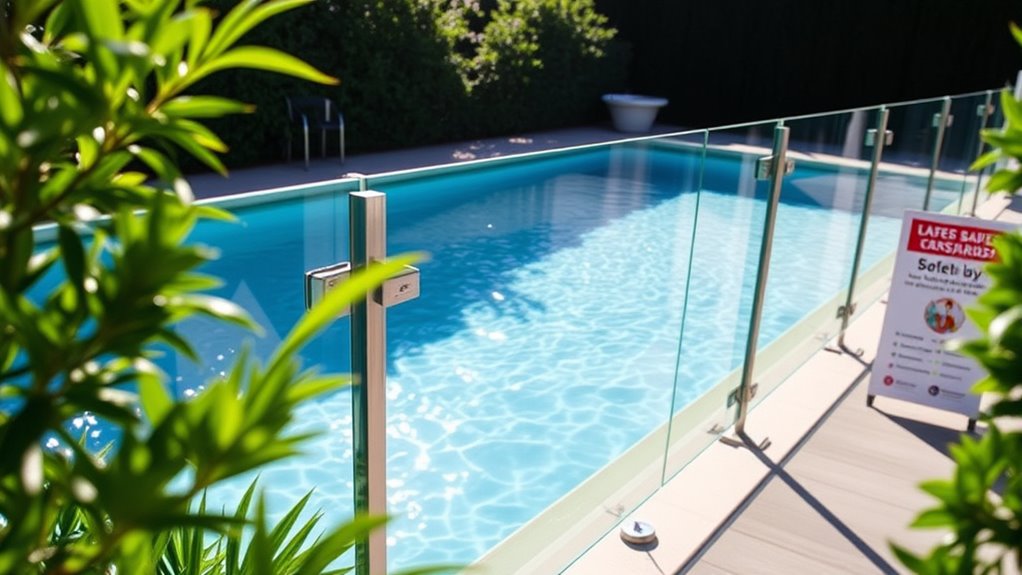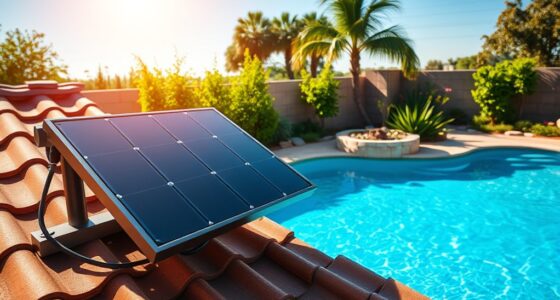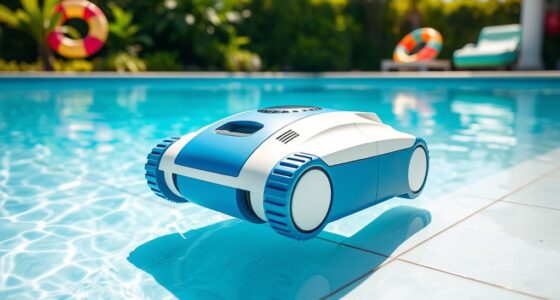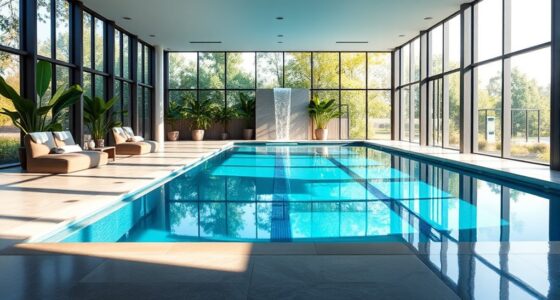When installing a pool fence, you need to guarantee it meets safety standards to protect young children. The minimum height should be at least 4 feet, and openings should prevent a 4-inch sphere from passing through. Choose durable materials like aluminum or mesh that resist weather conditions. Gates must have secure locks and open outward, with self-closing and self-latching features. If you want to learn more about specific regulations and design tips, there’s plenty to explore!
Key Takeaways
- Pool fences must be at least 4 feet high to effectively prevent accidental access by young children.
- Materials like aluminum, vinyl, mesh, and wrought iron offer various durability and maintenance levels for pool fences.
- Compliance with safety regulations includes openings that prevent a 4-inch sphere from passing through and restricts vertical member spacing to no more than 1¾ inches.
- Climb-resistant designs and proper placement of horizontal members enhance safety by discouraging children from climbing over or slipping through.
- Gates must have secure locks, self-closing, and self-latching mechanisms, and should open outward for added safety.
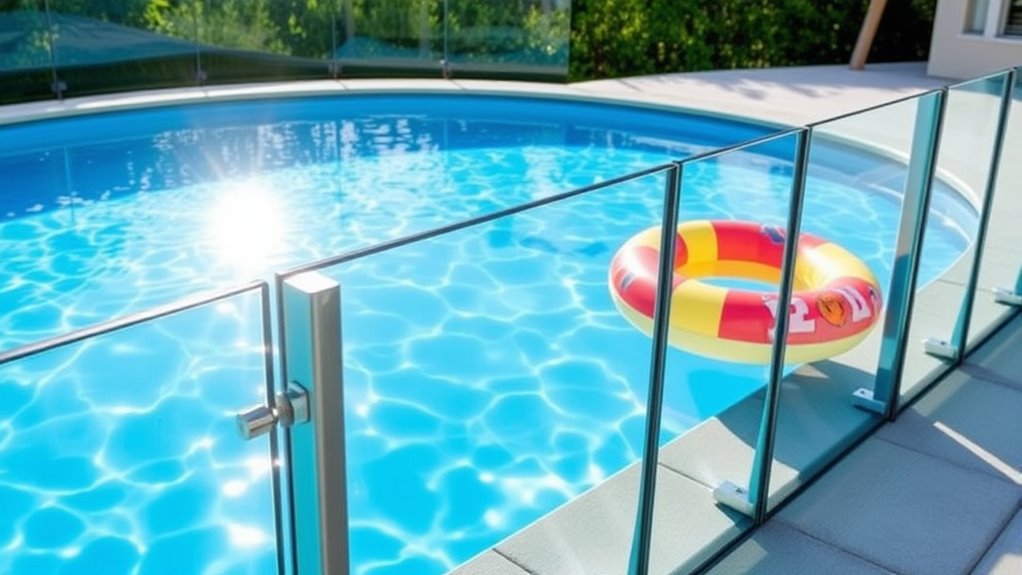
When it comes to guaranteeing the safety of your pool area, having a well-designed and compliant pool fence is fundamental. A sturdy fence not only provides peace of mind but also helps prevent accidents, especially with young children around. Ideally, your pool fence should stand at least 4 feet tall, meeting the minimum height requirement. If you have an above-ground pool, the fence can be installed either at ground level or mounted on the pool structure itself. Just remember, the vertical clearance between the top of the pool and the bottom of the barrier shouldn’t exceed 4 inches.
Choosing the right materials for your pool fence plays a significant role in its effectiveness. Popular options like aluminum, vinyl, mesh, and wrought iron offer durability and resilience against harsh weather conditions. If your area experiences high humidity or coastal exposure, make sure you select materials that resist corrosion.
Maintenance is another factor to take into account; some materials require more upkeep than others. Thankfully, many options come in aesthetic designs to complement your backyard decor, so you won’t have to sacrifice style for safety.
When it comes to openings and mesh size, you’ll want to make sure your fence complies with specific regulations. Openings should be small enough to prevent a 4-inch diameter sphere from passing through, which is essential for keeping children safe. For chain-link fences, the maximum mesh size shouldn’t exceed 1¼ inch square unless slats are utilized to reduce the openings.
Additionally, diagonal members in lattice fences should have a maximum opening of 1¾ inches, and any decorative cutouts mustn’t exceed 1¾ inches in width.
Spacing is key in your fence’s design, too. Vertical members shouldn’t exceed 1¾ inches apart, preventing small children from slipping through. If your horizontal members are less than 45 inches apart, position them on the pool side to deter climbing. A climb-resistant design is fundamental, guaranteeing your fence maintains its structural integrity while keeping little ones safe.
Finally, don’t overlook the gate requirements. Access gates must come equipped with a locking device for secure closure. They should open outward and be self-closing and self-latching, with locks placed out of reach of young children.
Frequently Asked Questions
What Materials Are Best for Pool Fences?
When choosing materials for pool fences, you’ll want to take into account durability, aesthetics, and maintenance.
Aluminum’s lightweight and rust-resistant qualities make it a popular choice, while wrought iron offers strength and elegance.
If you prefer a modern look, glass provides a sleek appearance, but keep in mind it needs extra care.
For a budget-friendly option, vinyl or polyester mesh can be effective, balancing safety and low maintenance requirements.
Each material has its unique advantages!
How Do I Maintain My Pool Fence?
To maintain your pool fence, treat it like a prized vintage car. Rinse it regularly with a garden hose to remove dirt.
Use mild detergent and a soft cloth for a thorough clean. Check for damage monthly, ensuring panels and latches are secure.
Lubricate hinges and locks with rust-resistant products, especially after bad weather.
Finally, apply weather-proof sealants to protect against the elements and keep it looking sharp for years!
Can I Install a Pool Fence Myself?
You can install a pool fence yourself, but be prepared for some challenges. It requires careful planning, proper tools, and an understanding of local regulations.
You’ll need to mark your area, drill holes for posts, and guarantee everything’s aligned correctly. If you’re unsure about any step, consider hiring a professional.
While DIY can save money, getting it right is essential for safety and compliance. Make certain you’re ready for the task!
Are There Decorative Options for Pool Fences?
When it comes to pool fences, think of them as the frame to your outdoor masterpiece.
You’ve got plenty of decorative options to enhance your yard’s appeal. Wrought iron adds elegance, while wood brings a rustic charm.
If you prefer a modern touch, glass can maintain stunning views. Bamboo offers a tropical vibe, and vinyl is low-maintenance.
Whichever you choose, guarantee it complements your overall landscape and style!
What Is the Average Cost of a Pool Fence?
When you’re considering a pool fence, the average cost hovers around $4,000, but you’ll find prices ranging between $1,500 and $10,000.
Factors like size, material, and height play an essential role in determining your total expenses.
If you opt for more economical materials like chain link or mesh, you could save money.
Just remember, hiring a professional for installation is vital for ensuring safety and compliance with local regulations.
Conclusion
When it comes to pool fences, you’ve got to prioritize both style and safety. By following the right design and safety standards, you can create a barrier that not only looks great but also keeps your loved ones safe. Remember, it’s better to be safe than sorry—investing in a solid pool fence means peace of mind for you and fun for everyone. So, take the plunge and make your pool area secure today!
